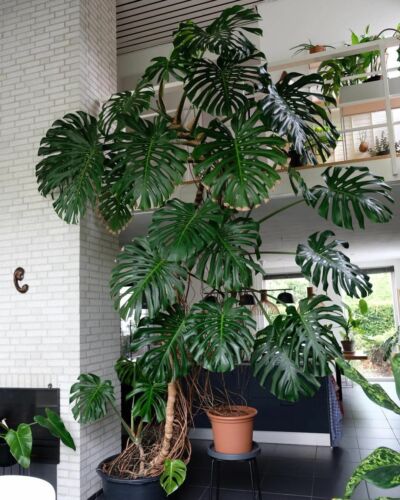
Also known as the Swiss Cheese plant, Monstera Deliciosa are native to Mexico and Central America. This tropical plant features leaves with holes, which lend to their exotic vibe. It needs moderate watering and indirect light (bright to medium is best).
The Monstera’s leaf-holes are called fenestrations and are theorized to maximize sun fleck capture on the forest floor by increasing the spread of the leaf while decreasing the mass of leaf cells to support.
Two different species of Monstera are cultivated as houseplants – Monstera deliciosa and Monstera adansonii. Monstera adansonii is distinguished from M. deliciosa by having longer, tapering leaves, as well as having completely enclosed leaf holes. Monstera deliciosa leaf holes eventually grow towards the edge and open as they mature.
They do produce edible fruit, especially Monstera deliciosa, though they rarely flower or produce edible fruit indoors. Monsteras were made known formally to the botanical world during the early 20th century, although they had been known for much longer by the indigenous peoples of Central America.
How to Care for Swiss Cheese Plant
Sunlight
This plant thrives in bright to medium indirect light. It is not suited for intense, direct sun but can be acclimated to withstand it.
Water
Water every 1-2 weeks, allowing the soil to dry out between waterings. Expect to water more often in brighter light and less often in lower light. Like many plants, Monsteras can benefit from filtered water or water left out overnight before using.
Humidity
Normal room humidity will do but they prefer humid conditions if possible.
Temperature
Most houseplants prefer temps in the 65°F-85°F range. It’s best not to let it go below 60°F.
Soil
Use a well-draining potting mix. Mix in ingredients such as perlite or lava rocks to increase soil aeration as need.
Common Problems
The Monstera is an easy-going plant and is generally pest-free. Treat pests as soon as they appear with weekly sprays of a natural pesticide like neem oil and regular wipe-downs of the plant.
| Plant Symptom | Cause |
| Leaves turning brown and crispy at the edges | Thirsty plant, underwatered or a high salt build up |
| Wilting plant, dry potting mix | Underwatered or pot-bound |
| Yellowing leaves or black stems, wet potting mix | Overwatered |
Monsteras can be irritating to cats, dogs, and humans if foliage consumed. The best practice is always to keep houseplants out of reach of small children and pets.
6 Fun Facts About Monsteras
They Can Get Very Tall
The Deliciosa can grow up to 70 feet tall and bear fruit in the wild.
Monstera Fruit is Delicious
In the wild, Monstera Deliciosa has incredibly rich fruit. It tastes like the combination of strawberries, passion fruit, mango, and pineapple and looks like a green ear of corn. The roots are used to make ropes and baskets in South America and as a snakebite remedy.
The Holes in Their Leaves Have a Purpose
Tropical rainforests are the natural habitat of the Monstera. By developing holes in its leaves, the large Monstera leaves are better suited to withstand heavy rainfall and wind as they let the elements pass through the holes. These abnormal leaves (monstera means strange in Latin) gave the plant its name. A Monstera leaf can’t create any extra holes during de lifespan of the leaf. All gaps already exist when the plant first produces the foliage. Older and healthier plants create leaves with increasingly more holes and older leaves with fewer holes tend to die off after some time.
It is Used to Make Furniture
The aerial roots from Monstera’s are used in Guatemala to make furniture that is like rotan furniture and baskets.
They Have Muscles
Sort off. We call this muscle the geniculum. It is the junction between the leaf blade and petiole. A geniculum is typical for the Monstera genus and allows the plant to direct its leaves towards the sun.
Monsteras Were First Discovered in 1693
The Monstera was first discovered and described by the French Botanist Charles Plumier.
Related Articles & Free Email Newsletter Sign Up
Oxalis is a Great Plant for Your Greenhouse




Comment here